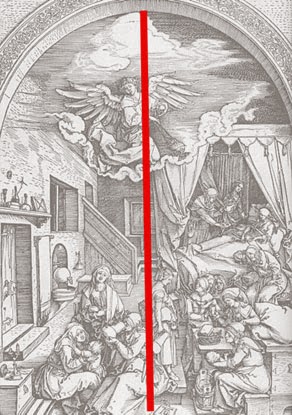In the last post on composition I talked about the use of
simple black and white images to study composition. In this short post I’ll
note some examples of values studies; explorations utilizing a range of grays.
In a way an illustration using a range of grays is simply a colorless
illustration. It is certainly both a step on the way to a full color image, and
a potentially final black and white image. I am not worried about this aspect,
but would rather point out the obvious; a simple value study is a good test of
whether a composition is effective or not.
Good composition demands that the artist assemble the work
so that any viewer can derive pleasure from the work as a whole, devoid of
details. So a test of composition is the elimination of details. The various
modern reactions to the bland academic painting of the 19th century (Impressionism,
Expressionism, Cubism, etc.) all tend to lose the detail and emphasize
composition. Even if you dislike the excesses of modern art you have to
appreciate what the original idea was.
James Whistler excelled at this seemingly simple task. All
his paintings capture the essence of the object or view, which is the point of
composition.
His Self Portrait, although a good enough likeness, is more
remarkable for its roughly abstracted blocks of tone and texture. Simplified
(in the lower image) it still has a compositional presence.
Whistler’s Nocturne
Trafalgar Square Chelsea Snow uses the same approach to illustrate London’s
famous urban space. It may not have any detail to keep your interest, but it
shows that he had an eye for composition.
Dream by Kati Olah
takes Whistler’s idea and makes a beautiful and believable painting.
This portrait sketch by John Singer Sargent is an example of
how an experienced artist works. A completely believable likeness is produced
with a minimal range of grays.
This quick study shows what can be created using black and
white pencil on colored paper. The forms are geometric and flat, but the soft
flesh is captured.
This torso study is even more abstracted, but still evokes
the human form.
This is my last planned post on composition, but I will certainly be pointing out compositional inspiration in the future. If you haven’t checked
out the previous posts on composition please do; the links are below.
A caveat for all posts on composition.
You don’t
want to produce total chaos.
You don’t
want to create banal order.
You do want
to entice, hint, and suggest.
You want to
create mystery, even if the subject appears to be obvious.
- Composition Part 1 - Architectural Illustration
- Composition Part 2 - The Golden Section & other crutches
- Composition Part 3 - Dark Spot
- Composition Part 4 - Light Spot
- Composition Part 5 - The Cross
- Composition Part 6 - The Pyramid
- Composition Part 7 - Circle
- Composition Part 8 - Diagonal
- Composition Part 9 - "L" Frame
- Composition Part 2 - The Golden Section & other crutches
- Composition Part 3 - Dark Spot
- Composition Part 4 - Light Spot
- Composition Part 5 - The Cross
- Composition Part 6 - The Pyramid
- Composition Part 7 - Circle
- Composition Part 8 - Diagonal
- Composition Part 9 - "L" Frame



































